Although I watch anime, I am not part of the full anime online scene. I tend to learn about new series through my RSS and ATOM feed collection – one source of information is Crunchyroll’s RSS feed (fitting since most of the series I watch are on Crunchyroll). On March 16, 2023, Crunchyroll published a news update titled Office ROM-com Anime My Tiny Senpai Stacks Up Details for July Premiere. The headline is a bit unclear, but the name of the anime itself is My Tiny Senpai. When I saw the title of this new series and the main screen grab for the article’s featured image, which features a blushing salary man carrying a small woman on his back who is presumably the tiny senpai (I assume she sprained her ankle or something to that effect), I felt a sense of deja vu.
Consider this post a stream of consciousness exploration of how two of the key stand-out features of this new My Tiny Senpai anime have previously appeared in anime series over the last 20 years. Firstly, I will examine anime office romantic comedies, which have been generally uncommon. Secondly, I will look at anime series that made a point of either highlighting a significant size difference between the main couple or that one half (almost always the woman) is particularly small.
- My Tiny Senpai reminds of My Senpai is Annoying
- Anime office rom-coms
- Recent anime rom-coms with focus on size of characters
- Older anime romances with significant character height/size differences
- Mediocre (in my estimation) anime romances that emphasize character size
- Above-average anime romances that emphasize character size
- Conclusion
My Tiny Senpai reminds of My Senpai is Annoying
In November 2021, I wrote an article about hair color in My Senpai is Annoying.
See Futaba Igarashi’s Hair Is Naturally Green?
That series featured a very diminutive office worker (Futaba Igarashi) and her very large, physically imposing senpai (senior, in this context), Harumi Takeda. That, too, was a romantic comedy with an office setting. Moreover, it featured a very small woman as the lead. Is this the new trend now? Anime office romantic comedies featuring very diminutive heroines?
There are some signs that something may be different happening with this My Tiny Senpai anime. One of the running jokes in My Senpai is Annoying was that Futaba was often mistaken for a middle school student, and she tended to adopt the mannerisms of one when she was flustered.

My Tiny Senpai seems to be adopting a different approach with its co-lead, Shirori Katase:
As previously reported, the story of the series follows Takuma Shinozaki, a new employee, and Shiori Katase, his tiny but busty superior in the same department. Shinozaki finds himself attracted to Katase, who is good at praising her juniors and also very attentive to their needs, and a “super sweet” office romantic comedy results.
Crunchyroll
(Perhaps this particular description of Ms. Katase was given to ensure that no one would mistake the series for the second season of My Senpai is Annoying.)
The description of Ms. Katase’s appearance betrays that one would not mistake her for being a middle school student. She is just short.
Anime office rom-coms
I suppose the entire description and aesthetic of Shiori in My Tiny Senpai is reminiscent of Lucy Yamagami in Servant X Service, an office anime romantic comedy that aired back in 2013. Lucy was short, but designed in such a way that no one would mistake her for a child. It has been many years since I watched Servant X Service (note: the servant in the title referred to civil servants, it is not a show about maids and butlers), but I do not recall Lucy’s height having been a big issue (it has been a while, however).
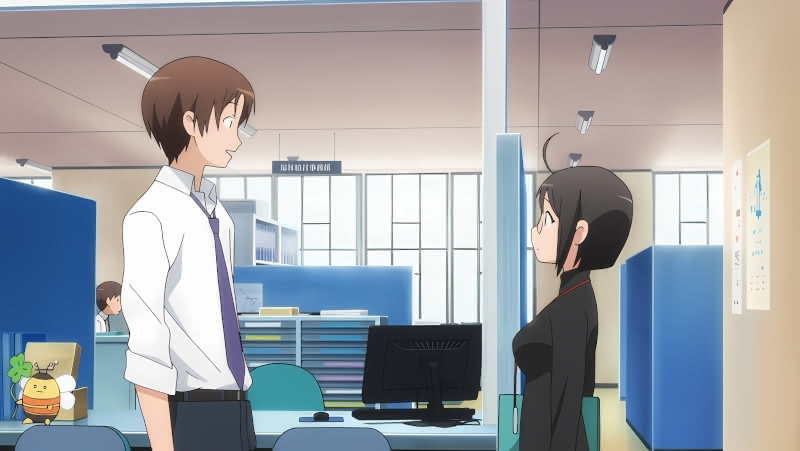
There is one aspect in which the scenario of My Tiny Senpai distinguishes itself from both Servant X Service and My Senpai is Annoying. Like the first two, it is set in an office and features a tiny woman as one half of the main duo. It appears to have an average-sized male lead, which is the same as Servant X Service but different than My Senpai is Annoying. In Servant X Service, both Lucy and the man who sought her affections, Yutaka Hasebe, were new civil servants. In My Senpai is Annoying, Futaba (the woman) was a relatively new employee working under the supervision of her senpai, Harumi. However, in this case, the tiny woman playing a leading role, Shiori Katase, is senior to the male protagonist, Takuma Shinozaki, who apparently develops feelings for her.
I thought of these comparisons because office romantic comedy is a relatively rare anime set-up. To the best of my recollection, the only two that I have previously watched are Servant X Service and My Senpai is Annoying.
(I am defining office romantic comedy as an anime series set in an office – to be distinguished from generic workplace anime (other workplace examples featured in my 2011-2020 anime decade review: Shirobako (anime studio), Sakura Quest (rural tourism office), and Girlish Number (anime voice acting agency)) – where both of the main characters work in said office but are not romantically inclined. The series must also be a romantic comedy, meaning that the romantic comedy aspect of the show must be one of its central focuses.)
The first two examples of office rom coms were decent. Servant X Service, based on a lite novel series, was the better of the two anime office romantic comedies that I saw, but it ended without really ending, which is an unfortunate (but not universal) trend in both the anime romance and romantic comedy genres. My Senpai Annoying was fun for its first two-thirds, but it suffered from a malady that I would describe as one joke syndrome, and it ran out of joke in its last episode as it meandered to a non-ending-ending similar to its workplace comedy predecessor.
I may give My Tiny Senpai a try in July. While it does not look like the type of series that would have a high ceiling, I suppose it could be decent enough, especially if it only suffers from a mild case of one-joke syndrome. If nothing else, it is refreshing to see some anime series with uncommon settings for the medium. Specifically, it is nice to see anything these days that does not revolve around some guy (or somewhat more uncommonly, lady) being sent to “another world” in which he or she suddenly gains video game powers.
(My view of the current isekai trend is less than favorable.)
Recent anime rom-coms with focus on size of characters
As I noted at the top, the fact that My Tiny Senpai has an office setting was not the only thing that caught my attention. The title highlights the fact that one half of the main romantic duo is tiny. I watched two non-workplace romantic comedies in 2022 – Aharen-san wa Hakarenai and When Will Ayumu Make His Move? – both of which emphasized the fact that the female protagonist was of small stature. Is this a trend now? Both of these series had the far more common high school setting. While neither featured in my 2022 review of the year that was in anime, both were somewhat decent.
See The Best of Anime in 2022: Year in Review
The protagonist of Aharen, Reina Aharen, was both tiny in stature and in voice. I dare say her small size was an even bigger plot element than was Futaba’s in My Senpai is Annoying. Most of the series’ episodes featured multiple skits involving Aharen, Raidou (here best friend and eventual love interest who is quite a bit larger than Aharen, although not a giant in and of himself). Raidou would generally help Aharen with something, but misunderstand what Ahren was thinking and let his imagination run wild, only to realize that whatever she wanted was not too dramatic.
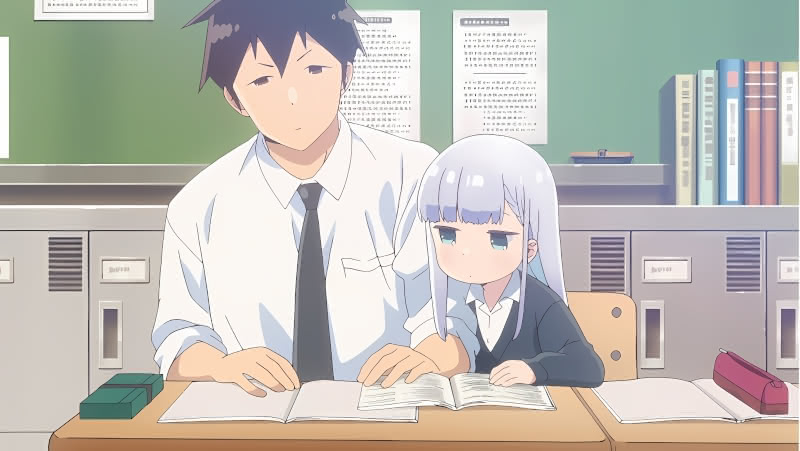
Most Aharen episodes are broken into 2-3 parts, with each part being something of a skit usually centered on Raidou trying to interpret what Aharen wants and letting his imagination run wild. Most of the skits did not land for me in the first half – nearly causing me to drop the series at the mid-way point – but I saw enough there to persist (especially since I had dropped 2-3 other series that season). It was stronger in the second half when it grew beyond its initial case of one-joke syndrome, doing a better job of mixing up the comedy and, surprisingly, advancing the central plot of Aharen’s and Raidou’s relationship to an unexpectedly decisive conclusion. My overall impression erred on the side of being positive, but I was let down by its inconsistency and the fact that most of the side-characters were annoying.
When Will Ayumu Make His Move? was based on a manga by Sōichirō Yamamoto, who notably pens the Teasing Master Takagi-san manga upon which my 2022 anime series of the year was based. I mentioned it briefly in that context in my section on the third season of Takagi-san:
Takagi-san was not the only 2022 anime based on a manga by Mr. Yamamoto. The summer season saw When Will Ayumu Make His Move? That series features two high school students, Ayumu and Urushi, who are part of a shogi club. Urushi, who is good at shogi, always beats Ayumu, who plans to confess his feelings for Urushi when he finally beats her. Ayumu was generally pleasant, but the magic of Takagi-san was not present. While the difference in quality between the two series is too great to be attributed to any one thing, one problem in Ayumu is that some of Takagi-san’s humor works precisely because the two protagonists are in middle school.
N.A. Ferrell in 2022 anime year-in-review
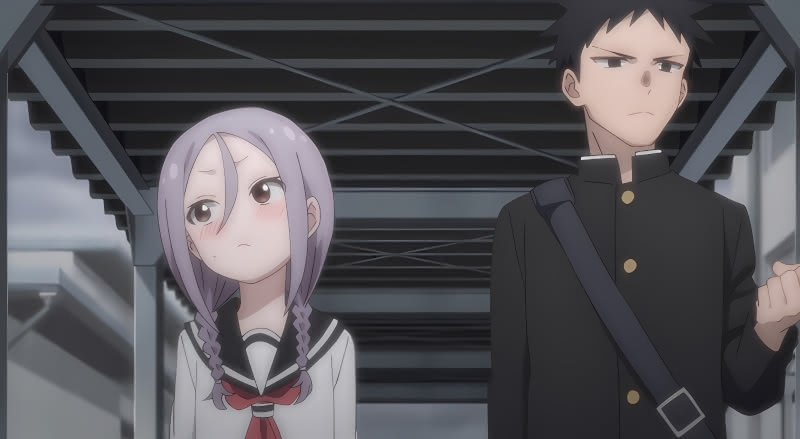
I do not have too much to add. Ayumu is firmly alright – generally pleasant but ultimately forgettable. Yaotome Urushi, who begins the series as a second-year high school student (equivalent to 11th grade in the United States) and concludes as a third-year, is notably very small – albeit not as exaggerated as Futaba and Aharen. Ayumu, who towers over Urushi, is not unusually tall, but he is physically contrasted with her by the fact that he had been a top-ranked kendo practitioner in middle school before dropping his athletic aspirations because he preferred to spend his time losing to Urushi in shogi. Urushi’s stature did not dominate the show, but it was regularly noted both by people around her and for the inconveniences it sometimes caused her.
Older anime romances with significant character height/size differences
Having started thinking about recent anime series that highlighted a size difference between protagonists, I raked my brain for other cases of the phenomenon. I limited the inquiry to series wherein a romance (or would-be romance) was a central plot element and the characters in question were the series’ main characters. For this inquiry, I will include romances that are not comedies – for the office trio that inspired the case study just happened to all be comedies. Moreover, either the size difference between the main pair or the fact that one half of the pair is short or petite has to be a point of emphasis in the series.
My initial impression after having consulted my recollections is that this is not an especially common theme in anime romances, at least those worth remembering. For example, of all the anime series I recommended in my article on recommended anime series from the 2011-2020 decade, no series fully satisfies my criteria, although we do have a borderline case in Croisée in a Foreign Labyrinth. That series, set in late 19th century France, featured Yune, a very diminutive Japanese girl staying with a family in France for study abroad. I would not describe it as a show focused on romance, notwithstanding its focus on the interactions between Yune and the similarly aged Claude, but Yune’s stature is enough of a plot point of emphasis that it bears mentioning here despite the genre mismatch.
Mediocre (in my estimation) anime romances that emphasize character size
The anime romance series that made the biggest (pun intended) point of a size difference between the main pair was 2015’s My Love Story!! – which featured the budding relationship of the very large, muscular, but sweet and misunderstood Takeo Gōda, and the demure Rinko Yamato. The series focused more on how large Takeo is than how small Rinko is.

While not lacking in saccharine qualities, I ultimately found the anime series underwhelming due to there not being much of a there there, an issue which is more of a problem over the course of 24 episodes than in a shorter 12-episode series like When Will Ayumu Make His Move? But it fits the theme too well to escape mention.
Another series that fits despite my not particularly liking it is Gosick, which aired for 24 episodes in 2011 and stars a very tiny French detective (or technically the brains behind her brother, who is actually the detective) named Victorique de Blois and her unwitting assistant, Kazuya Kujo.

Gosick is primarily focused on being a mystery anime with an early twentieth century European setting, but the relationship between Vitorique and Kazuya dominates the story, granting the romance is largely relegated to undertones. Kazuya is of average stature, but Victorique is tiny. That Victorique is tiny is noted and, in any event, would be impossible to miss.
I will also include School Rumble on this list in the exercise of my discretion. It aired in two 26-episode seasons from 2004-2006. School Rumble, despite its intimidating name, is an absurd high school romantic comedy featuring many characters (the roster expands seemingly exponentially) who are in love with someone who loves someone else. Had it seen fit to actually resolve any of these cases of unrequited love, it potentially could have been something. But in line with some of the dominant trends in anime adaptations of the era – actually resolving things somewhere in the course of 52 episodes would have been too easy (a two-episode OVA resolved some things, but not necessarily to the series’ benefit). But I digress. The nominal main characters are the small Tenma Tsukamoto, who while not tiny, is small and often mistaken for being younger than she is, and Kenji Harima, a large and absurdly muscular ex-delinquent with a big heart.
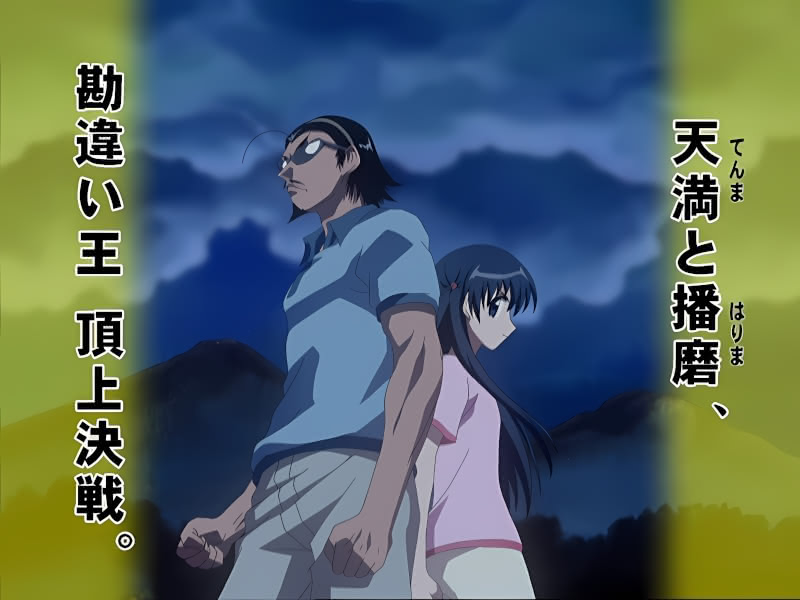
Harima loves Tenma who in turn loves a silent boy in her class named Oji Karasuma. While Harima’s love is one-sided (which in turn leads to one-sided loves directed at Harima), the centrality of the Tenma-Harima-Karasuma plot earns School Rumble a note on this list.
Above-average anime romances that emphasize character size
One may think that, at least in my analysis, anime series highlighting a size difference between the main pair are generally middling. But we do have a few examples of better series with this emphasis. I settled on four cases to highlight (not necessarily exhaustive).
Honey and Clover, which aired for two seasons (36 episodes total) in 2005 and 2006 is one of the finer series of the 2001-2010 decade. (It is based on a manga by Ms. Chica Umino, who would later pen a manga called March Comes in like a Lion, which in turn was adapted into what I rated as the best anime series of the 2011-2020 decade.) Honey and Clover is a solid drama that occasionally dabbles in comedy (to its detriment). It follows a number of characters and relationships, making it difficult to single out any of its main five characters. But taking the series as a whole, the diminutive Hagumi Hanamoto stands princeps inter pars in the cast. She begins the series as a tiny 18 year old woman, easily mistaken for being younger, and likely the most talented artist in a series where all of the main characters are artists. Over the course of the series, she eventually becomes the center of a love triangle – the nature of which and its resolution are beyond the scope of the instant inquiry.
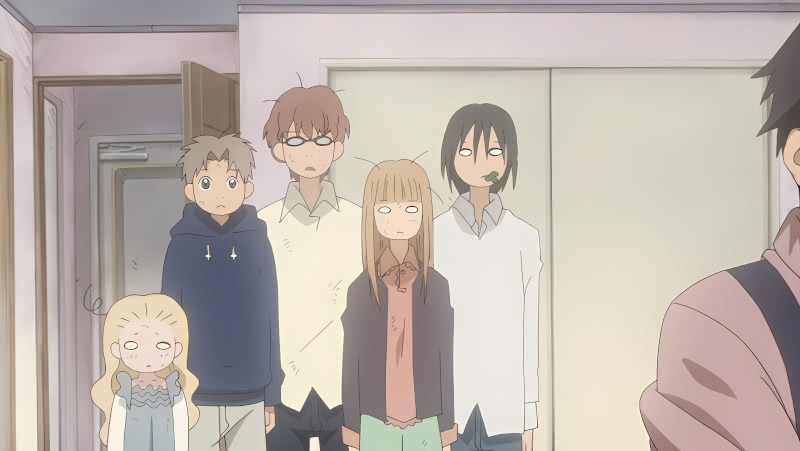
While the two male members of the love triangle are neither unusually large nor small, Hagu’s petite statute is both noted in the series and impossible to not ocularly apprehend. Much like Futaba in My Senpai is Annoying, Hagu’s manner and mannerisms would not have the tendency to dissuade one from mistaking her for younger than she is.
Sing “Yesterday” For Me, which aired in 2020, is a somewhat brooding drama set at the end of the 1990s featuring two love triangles among four characters (could make for an interesting diagram). Two-thirds of the triangle that matters (the less said about the other, the better) are Rukuo Uozumi, a listless 22-23 year old college graduate working at a convenience store, and Haru Nonaka, an 18-year old high school drop out working as a waitress. Rikuo is an average guy in all physical respects, but the eccentric Haru is rather small. Haru is in love with Rukuo, who in turn is in love with one of his friends from college.

While Haru’s being short and looking young is less prominent than her eccentric personality, her appearance is relevant to her ongoing struggle to make Rikuo take her seriously as an adult (the extent to which her pet crow helps or hinders her endeavor is beyond the scope of our limited inquiry). Yesterday has numerous faults, but I thought enough of its setting, ambiance, and effective conclusion to include it as an additional recommendation on list of 2011-2020 anime choices for general audiences.
Toradora!, set in a high school, aired in 2009 – and it is in many ways a textbook high school-based anime romantic comedy. While it has some significant faults often derived by excesses in melodrama and a somewhat rushed (but nevertheless interesting) conclusion, its good qualities overcome the bad in the final analysis. While Toradora!has several key characters, the leads are clearly Ryuji Takasu, an ordinary nice guy with a penchant for cooking and cleaning and unfortunately scary eyes, and the tiny, lonely, and somewhat temperamental Taiga Aisaka.
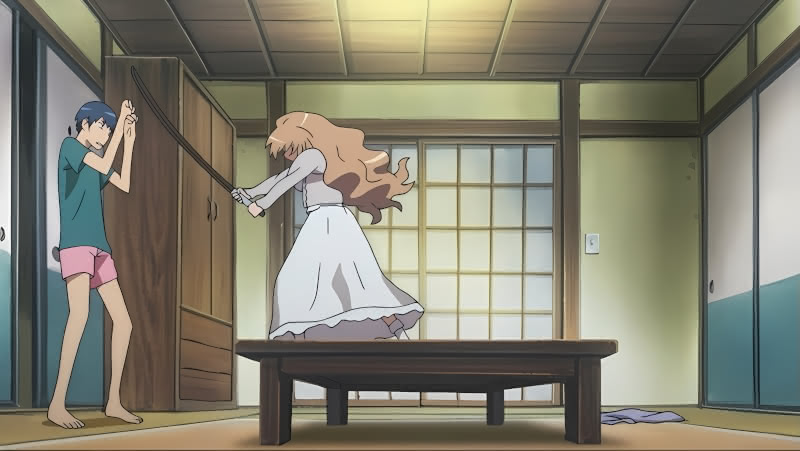
The combination of Taiga’s tiny stature and quick temper earn her the nickname “Palmtop Tiger” in the show, so her size is both a focus of her peers and hard to miss for viewers. With that being said, the fact that Taiga is small is not a focus of her peculiar relationship with Ryuji – which is the central plot issue in Toradora! – as it evolves through the series.
The unique case of Lovely Complex
I conclude with the most interesting case I will discuss here: Lovely Complex. Every previous series I mentioned involved a relationship where the petite half was the woman. Lovely Complex reversed the trend: The series centers on the growing feelings between Risa Koizumi, a relatively tall (5’8”) high school girl, and the significantly shorter Atsushi Ōtani (5’1”).
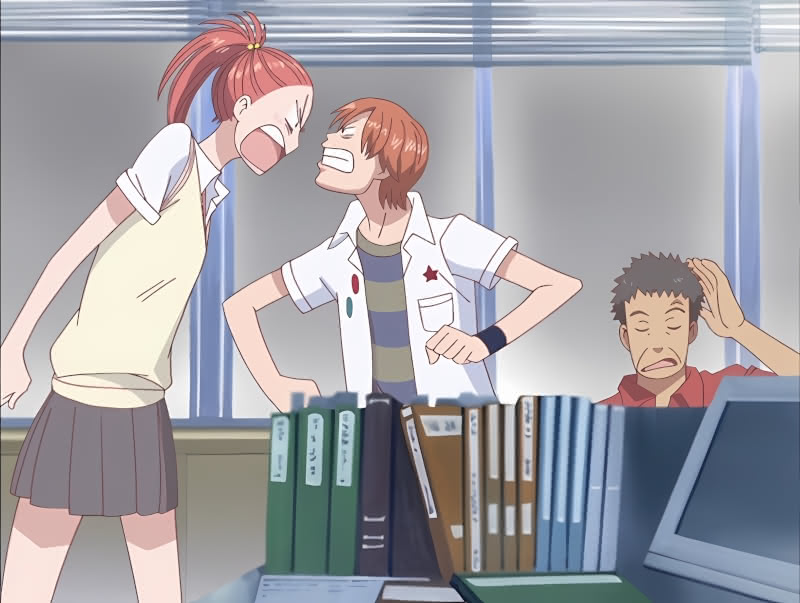
Height is a big issue for both. Risa is sensitive about being tall and not being viewed as feminine whereas Ōtani is sensitive about being short and not being viewed as manly. Their interests – Risa being interested in fashion and Ōtani in basketball – are also relevant. The series, which aired for 24 episodes in 2007, focuses on their somewhat antagonistic friendship turning into something more, initially on Risa’s end – and their respective complexes about their heights are always present. Lovely Complex is surprisingly solid, especially in its very humane portrait of Risa’s evolving feelings, but it would have probably benefited from being less than 24 episodes.
Honorable mentions
I will note several borderline cases that I could have included, but ultimately opted not to in the exercise of discretion, before my conclusion.
I will omit discussing the 2006 adaptation of Kanon, which is one of my favorite series of the 2001-2010 decade, because it would require too much introduction. But one could make a case for Ayu Tsukimiya satisfying the list criteria.
Working!! is a workplace romantic comedy from the pen of the same manga artist behind Servant X Service. One of its main characters (and proverbial mascot), Popura Taneshima, is small and mistaken for being much younger than she is, despite being 17 at the start of the show. She is sensitive about her height. That she was named after the poplar tree is not lost on her.
True Tears is a complicated romantic drama that defies easy disentanglement. I remembered one of the three main characters, Noe Isurugi, being short (she reminds me quite a bit of Haru from Sing “Yesterday” For Me, so much so I may do a comparison at some point). However, Noe is not that short, especially compared to her love interest, and I do not recall her height having been an issue in the series.
Conclusion
Having gone through this stream of consciousness, let us wrap up with some conclusions.
Firstly, office-based anime romantic comedies are quite uncommon – there has been are only a handful of them in recent years. The list does not grow much longer if you expand the criteria to include workplace-based series such as Wagarnia!! In my 2022 anime year in review wherein I selected the third season of Teasing Master Takagi-san as my anime of the year, I noted that this was the only occasion in the 18 years I have seen enough anime to write such a list that I selected a romantic comedy as the best overall series of the year. Moreover, Takagi had a somewhat unusual (although not uncommon per se) middle school setting. Thus, I have no particular attachment to wanting more non-high school romantic comedies, but it is nice to see series set in workplaces instead of the usual high school or the increasingly, unfortunately common, “other world” setting, which has become the dominant trend of late. To that extent, the set-up for My Tiny Senpai is refreshing even though I suspect that the series will have a limited ceiling.
Secondly, I thought of something interesting regarding the target demographics of the series I cited for featuring a main romantic pair where character size was an emphasis. Of the series I noted, only Honey and Clover and Lovely Complex clearly have women in mind as the primary target demographic (feel free to correct me via email if you disagree with respect to any of the series I noted). I would describe the remainder of the series as either being entirely agnostic with respect to their target demographics (e.g., My Senpai is Annoying) or male-leaning (e.g., School Rumble).
Moreover, only three of the series that I noted – Lovely Complex, Croisée in a Foreign Labyrinth, and My Senpai is Annoying – employ a female character as the dominant view-point character (this is subjective and/or borderline in some of the cases, but I will define the concept as where we see most of the events through the eyes of a particular character). None of this is to say that any of the series I highlighted are particularly masculine in tone – for example, to the extent that Toradora! could be described as wish-fulfillment – the wish fulfillment is largely on Taiga’s end.
I have seen a decent selection of shoujo anime and josei anime. Shoujo anime is generally based on source material published in compendiums with young women as the target demographic (Kimi ni Todoke, which I covered in an unusual way, is a good example), and josei is aimed at adult women (Honey and Clover is an example). Why do we see so few well-known shoujo and josei anime on this list of workplace anime? I have a small theory.
Most anime romances aimed at women tend to feature an ordinary, average protagonist – likely someone that the median reader may be able to relate to. The love interest(s) come in different forms. You have cases where the main protagonist falls in love with an ordinary guy (Lovely Complex is a fair enough example – shortness of the love interest aside), a troubled guy (We Were There, not covered here, is a good example), or a proverbial dreamboat (Kimi ni Todoke). Then you have the full wish-fulfillment-type series where the ordinary girl or woman attracts the attention of multiple, almost impossibly dreamy guys (I will cite to 2019’s Meiji Tokyo Renka as a somewhat recent example).
When you look at the dominant types of anime romances aimed at adolescent girls and young women, it is not too surprising that few feature unusually small female protagonists. While Japanese women are not short on average compared to women from many other countries, most are significantly taller than Toradora’s 4’8” Taiga. If one is writing a protagonist who can serve as somewhat of an insert character, one will generally avoid having something uncommon define her character. I will note that in the case of full otome (otherwise known as reverse-harem) series, I am not aware of any examples where the female protagonist (read insert character) is not generally average. However, in making that observation, I also note that this is unsurprisingly not a genre I have much experience with, so there may be other examples that I am unaware of.
What of the exceptions in our sample? Hagu in Honey and Clover is an exception, but that series features a large cast, and Hagu is the only unusually small female character. Lovely Complex is our most interesting case. Risa is tall, but at 5’8”, she is simply taller than average rather than a giant in the mold of Harumi Takeda in My Senpai is Annoying. To the extent the show focuses on height, the idea of a woman being self-conscious about being taller than average or interested in a man who is shorter than her is likely relatable to many readers (granting the difference in couples where the woman is taller than the man is less than 7 inches in the vast majority of cases). Moreover, to the extent Lovely Complex has broader appeal, the reverse situation, where a short man has some interest in a taller woman, can also be relatable.
There are other exceptions to different degrees in the broad genre of anime romances with a female demographic in mind, two of which I have discussed tangentially here at The New Leaf Journal. Yukino Miyazawa of His and Her Circumstances is portrayed as being attractive and one of the two best students in her school, but her primary issue in the show – a tendency to put on a mask to show the public her best face – is a relatable idea even if your average viewer is not or was not a top student. Sawako Kuronuma of Kimi ni Todoke is portrayed as a textbook case of Asperger’s Syndrome without it ever being expressly stated in the series – which (contrary to what some of the people on social media may tell you) is not especially common. But many of Sawako’s struggles with confidence and uncertainty may be relatable to a broader audience.)
This concludes my stream of consciousness survey of two aspects found in My Tiny Senpai: anime office romantic comedies and anime romances in which the height difference between the main pair is a key point of the series. While I doubt that anime series with office settings are a new trend, the jury may be out on romantic comedies featuring a very short young woman. Perhaps something in the two 2022 examples I noted inspired more? I suppose we will see in the coming months.